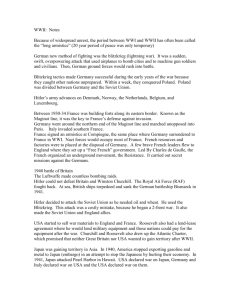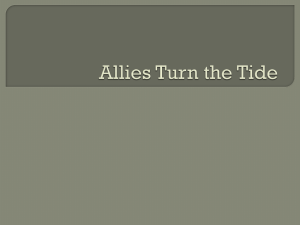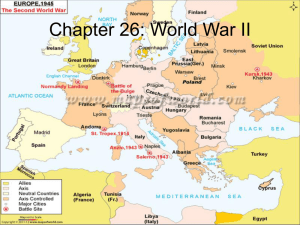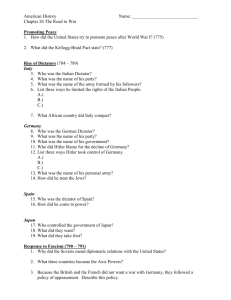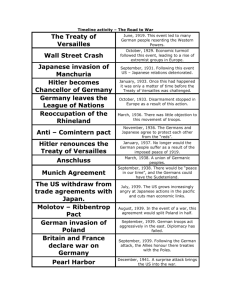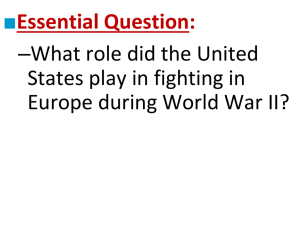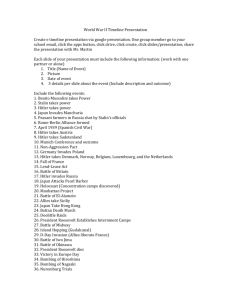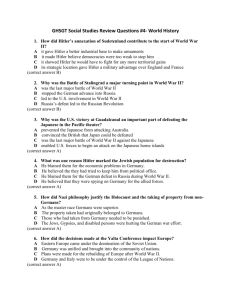World War II
advertisement
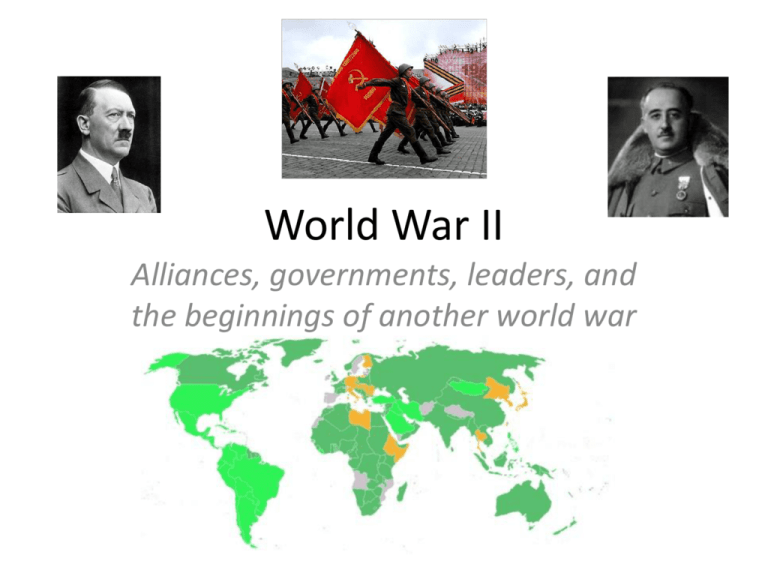
World War II Alliances, governments, leaders, and the beginnings of another world war HOME 24 World War Looms TIME LINE The United States The World 1931 The Empire State Building opens in New York City. 1931 Japan conquers Manchuria, in northern China. 1932 Franklin Delano Roosevelt is elected president. 1933 Prohibition ends. 1933 Adolf Hitler is appointed German chancellor and sets up Dachau concentration camp. 1934 Stalin begins great purge in USSR. Chinese communists flee in the Long March. 1936 Jesse Owens wins four gold medals at Olympics in Berlin, Germany. Roosevelt is reelected. 1936 Ethiopia’s Haile Selassie asks League of Nations for help against Italian invasion. General Francisco Franco leads a fascist rebellion in Spain. 1937 Amelia Earhart mysteriously disappears attempting solo round-the-world flight. continued . . . HOME 24 World War Looms TIME LINE The United States The World 1938 Orson Welles broadcasts The War of the Worlds, a fictional alien invasion. 1938 Kristallnacht—Nazis riot, destroying Jewish neighborhoods. 1939 Germany invades Poland. Britain and France declare war. 1940 Roosevelt is elected to a third term. 1941 United States enters World War II. 1941 Japan bombs Pearl Harbor. HOME 1 Dictators Threaten World Peace OVERVIEW MAIN IDEA WHY IT MATTERS NOW The rise of rulers with total power in Europe and Asia led to World War II. Dictators of the 1930s and 1940s changed the course of history, making world leaders especially watchful for the actions of dictators today. TERMS & NAMES • Joseph Stalin • fascism • Benito Mussolini • Adolf Hitler • Nazism • Francisco Franco • Neutrality Acts • totalitarian ASSESSMENT HOME 1 Dictators Threaten World Peace ASSESSMENT 1. Identify the main ambitions of each dictator listed in the web diagram. Stalin: Create a model Communist state and transform the Soviet Union into a great industrial power Dictator’s Ambitions Hitler: Unite the German “master race” into an empire destined to rule the world Mussolini: Franco: Make Italy a great world power Become Spain’s supreme military leader continued . . . Ideologies & Gov’ts • Fascism – stresses nationalism; places interest of state above people; power rests with one strong leader & his party • Nazism – a.k.a. National Socialism; form of fascism; extreme national pride & superiority; racial elements; returning to “old glory” of country & people • Communism – gov’t & economic system; industry is state-run; little or no private business or property • Totalitarian – any gov’t that exerts complete control over its people & suppresses opposition – Any of the above forms can become totalitarian Setting the Stage • Treaty of Versailles (TOV) caused problems – Germany stripped of colonies & territories; no army; owed reparations ($) – Russia lost territory (Poland, Czechoslovakia, Yugoslavia & the Baltic nations became sovereign) • New democratic nations struggled – Russia Soviet Union in 1922 after civil war – Italy faced unemployment, inflation, & threat of communist state – Weimar Republic in Germany couldn’t restore prosperity after TOV & impacts of Great Depression • People sought strong leadership & national pride Initial Actions • Stalin, in his effort to turn the SU into an industrial leader, purges anyone who threatens his power; ~10 million killed • Mussolini establishes a fascist state in Italy & begins expanding – conquers Ethiopia in 1936 • Hitler leads the Nazi party & is appointed chancellor in 1933; begins rearmament in 1935; invades the Rhineland to gain more lebensraum (living space) in 1936 Initial Actions • Hideki Tojo leads Japanese militarists to take control of the gov’t & invade Manchuria in 1931 • Francisco Franco leads a fascist revolution in Spain to overthrow the gov’t, starting the Spanish Civil War; becomes dictator in 1939 Response • League of Nations does almost nothing to stop these actions – Issues warnings & threats of “collective resistance”, but does not follow through • US maintains neutrality & isolationism – Signs Kellogg-Briand Pact in 1928 – Small force of troops fights against Franco in the Spanish Civil War (not successful) – Pass series of Neutrality Acts banning arms sales & loans to countries at war Warnings • Both Hitler & Mussolini say they will turn to violence if needed to reach their goals – “Italy wants peace, work, and calm. I will give these things with love if possible, with force if necessary.” – Benito Mussolini • Roosevelt speaks against continued isolation – “The peace, the freedom, and the security of 90 percent of the population of the world is being jeopardized by the remaining 10 percent who are threatening a breakdown of all international order and law. Surely the 90 percent…can and must find some way…to preserve peace.” – Theodore Roosevelt, 1937 • Ethiopian emperor Haile Selassie begs the League of Nations to intervene against Italy’s invasion - “It is us today. It will be you tomorrow.” HOME MAP 2 War in Europe OVERVIEW MAIN IDEA WHY IT MATTERS NOW Using the sudden mass attack called blitzkrieg, Germany invaded and quickly conquered many European countries. Hitler’s actions started World War II and still serve as a warning to be vigilant about totalitarian government. TERMS & NAMES • Charles de Gaulle • blitzkrieg • nonaggression pact • Winston Churchill • appeasement • Neville Chamberlain ASSESSMENT Vocab to Remember • Anschluss – political & economic union • Plebiscite – means of showcasing popular support for the action being taken (as a way of proving that the people were in agreement). – often fixed and did not ACTUALLY reflect the people’s approval • Reich – “realm” or “empire”; a perceived encompassment of all German people & territory throughout the world – the entirety of what Germany had the right to control & utilize. – Hitler wanted to est. the “Third Reich” • Appeasement – making concessions to an aggressor in order to avoid war – policy taken by Britain & France in signing the Munich Pact – believed it was the best course of action to prevent another world war The Beginnings of War • 1938 – Germany invades Austria – Feb: Chancellor Schuschnigg of Austria visits Hitler, who demands a shift in power to members of Austrian Nazi party – March 9: With mixed public opinion, Schuschnigg calls for a plebiscite – March 12: Germany invades Austria & declares Anschluss; Schuschnigg arrested – March 16: Mussolini states his approval of the annexation (though Italy had been Austria’s ally) – April 10: Plebiscite is held in Austria & Germany to gauge support; result = ~99% in both countries – Sept 24: Hitler makes first official demands for Sudetenland (in Czechoslovakia) & Sudeten Germans to be returned to the Reich; threatens mobilization by Oct 1 – Sept 30: France, Great Britain & Italy sign Munich Pact with Germany • 1939 – Germany invades Czechoslovakia & Poland; USSR invades Finland – – – – – March: invasion of Czech. Aug: Germany & USSR sign non-aggression pact, dividing up Poland Sept: Germany invades Poland; blitzkrieg with Luftwaffe Sept: France & Britain declare war on Germany Nov: USSR invades Finland German depiction of the Anschluss • This is part of a painting by Rudolf Hermann Eisenmemger titled “Austria Comes Home.” It depicts an Austrian freed from chains marching alongside the swastika flag. The event portrayed is the Anschluß with Austria in 1938. • Source: Die Kunst im Deutschen Reich, March 1941. The Munich Pact • In 1939, Britain & France meet with Germany to work out an agreement • Germany makes a list of demands, including expanded territory & that Sudeten Germans be returned to the Reich • Chamberlain, Daladier, Mussolini & Hitler sign the Pact • Should they have signed it?? Questions to Consider • • • • • • • • • Can we trust that this will be Hitler’s last set of demands? What has he said or done that would suggest that this will satisfy him? What would happen if we denied his demands and refused to authorize this? Can we trust Germany to abide by its pacts and agreements? How have they respected other treaties in the past (with Austria, with Czechoslovakia, the Treaty of Versailles)? Why isn’t Czechoslovakia in this meeting? How will signing this affect our alliances with other countries? Our reputation? Do the Sudeten people WANT to return to the German Reich? Would Czechoslovakia be benefitted or harmed by letting them leave? By giving up territory? How does the memory of WWI (the war overall and Germany’s role) play into this decision? What series of events led up to the Austrian Anschluss that could be a predictor of how this will turn out? What is the motivation behind reunifying the German Reich? Is it for national unity? Or political/economic dominance in Europe? • 1940 – war begins with major Axis advances – Spring: USSR takes eastern Poland, Estonia, Latvia & Lithuania – Spring: Germany invades Norway & Denmark (claiming to be protecting them from USSR; really getting ready for attack on Great Britain); also invades Netherlands, Belgium & Luxembourg – Britain & France try to hold Germany back at the Maginot Line; Hitler goes around them through Ardennes – Germany pushes Allied forces to Dunkirk (edge of the English Channel); meanwhile, Italy joins Axis powers & invades southern France – June: France surrenders to Germany; Charles De Gaulle flees to England & sets up gov’t in exile – Summer: Battle of Britain begins – Germany invades along French coast by air (Luftwaffe); 2 months of air raids over London (~2,600 planes) – Sept: Britain’s Royal Air Force (RAF) uses radar to track German planes; shoots down >185 German planes – Oct 31: Hitler calls off the invasion; continued air raids between the 2 nations The Holocaust Let’s clear some things up! • Did not arise from nowhere or only in Germany – LONG history of anti-Semitism in many countries – Christians; social Darwinists (eugenics movement); many cultures that saw Jews as “different” & “inferior” & blamed them for specific problems (like the plague) • Jews were not the only target • Not the cause of WWII • Occurred in 5 stages – Identification & stripping of rights, segregation, concentration, “final solution”, aftermath – More extreme stages took place during WWII; discrimination & loss of some rights happened earlier • 1930s began widespread boycotts of Jewish businesses • Nuremberg Laws (1935) officially defined “Jewish” & began stripping rights • Quickly escalated to violence, segregation, and the opening of camps – http://www.youtube.com/watch?v=1 PNjQi1Pmkc • Hitler’s “final solution” was to exterminate all Jews who had not yet fled the country – Genocide – deliberate & systematic killing of an entire population – Elite SS (security squadron) rounded up Jews; either killed immediately or sent to camps – MANY deaths; medical experiments – Extermination camps made specifically for mass killings (gunshot, starvation, poison gas) • Auschwitz = largest death camp (>12,000 killed/day) • 6 million Jewish people killed throughout Holocaust Aftermath • FLOOD of Jewish refugees (during & after); many countries started to restrict immigration & set up quotas – Afraid of: overcrowding, job competition – Plight of the St. Louis • ocean-liner from Germany carrying 900+ passengers towards Miami; turned away by Coast Guard & sent back to Europe U.S. Goes to War • FDR pushes boundaries of neutrality – Wanted to help France & Britain without actually going to war – 1939: added “cash-and-carry” provision to Neutrality Acts • Germany responds – Seeing that the US might get involved, Germany signed Tripartite Pact with Italy & Japan – became known as “Axis Powers” – Hitler invaded USSR, breaking non-aggression pact The Two Sides of WWII • “Big Three” Allied leaders: Stalin, Roosevelt, & Churchill • Axis leaders: Mussolini, Hitler, Tojo (P.M. & military leader), Hirohito (emperor) • Seeing the Nazis gain ground in 1940, US starts preparing (despite isolationists’ protests) – Selective Training & Service Act – 1st peacetime military draft; 16 million men registered, 1 million drafted – FDR proposed Lend-Lease Plan – US would lend or lease weapons & supplies to “any country whose defense was vital to the US” • Involved in attacks against German U-boats by 1941 – German wolf packs of submarines (U-boats) attacked convoys of supply ships crossing the Atlantic to prevent Britain from receiving supplies, weapons & troops – Battle of the Atlantic – ongoing 1939-1945; Allied victory in 1945 due largely to technology like sonar • Secret agreement with Allies – FDR & Churchill signed Atlantic Charter in 1941 – 26 other nations signed on – FDR said he would “wage war” and try to “force an incident” • Japanese action prompts war declaration – Tojo launched attack of China & “Indochina” – US protested with trade embargo – Prime Minister Tojo promised Emperor Hirohito to attempt to preserve peace with U.S.; but in Nov. 1941, ordered the navy to prepare for attack – US decoded Japanese messages & learned there would be an attack – but not WHERE – Dec. 7, 1941 = attack on Pearl Harbor; in 2 hours, US lost 2,400 lives, 21 ships & 300 aircraft. – US declared war on Japan Dec. 8 Preparing for War American People • Selective Service system expands – drafts another 10 mil (in addition to the 5 mil who volunteered) • Gen. Marshall (Army C.O.S.) forms the WAAC (Women’s Auxiliary Army Corps) to get women working in non-combat roles (nurses, radio operators, etc.) • Minority groups enlist (despite racial tension) – 300,000 Mexican Americans; 1 mil African Americans; 13,000 Chinese Americans; 33,000 Japanese Americans; 25,000 Native Americans Industries • Automobile plants reconfigured to produce tanks, planes, boats & military cars • Factories mass produce war products – Mechanical pencils bomb parts – Bedspreads mosquito netting – Soda bottling filling shells w/ explosives • By 1944, 18 mil workers in war industries – Provided supplies & helped the economy Federal Government Operations • FDR created OSDR (Office of Scientific Research & Development) – Worked on radar, sonar, pesticides, penicillin – Also began secret development of atomic bomb (Manhattan Project) • OPA (Office of Price Administration) – Froze prices to fight inflation; raised & extended taxes – Gov’t encouraged Americans to buy war bonds – WPB (War Production Board) organized drives to collect scrap metal, cans, paper & other materials to recycle into war products • Rationing – citizens had fixed allotments of goods that were “essential” for military operations – Meat, sugar, coffee, gasoline, shoes Codes & Code Breaking • “Tango hotel uniform romeo sierra delta alpha yankee” • Many countries used coded radio messages to communicate information or to plan attacks – Words had to be unmistakable: 5 and 9 can sound the same; say “fife” & “niner” instead – Yet their meanings had to be indecipherable to enemies • The Navajo Code Talkers played a big role in helping the Allies send messages that, even if intercepted by the enemy, could not be understood – Thousands of Navajos served in some form – Language unique to N. America • http://www.history.co.uk/studytopics/history-of-ww2/code-breaking The European Theater • 1941 – Churchill comes to U.S. for war plans • Feb. 1943 – Allied victory in Stalingrad – German Luftwaffe bombs Soviets, significant losses (1.1 mil) – point: Soviets trap Germans in the city & cut off supplies surrender – From then on, Soviets reverse the German advance & push them back to the east • May 1943 – “Desert Fox” Rommel surrenders in N. Africa (Operation Torch) – Allies invade Axis-controlled N. Africa – Dwight D. Eisenhower becomes an important figure, planning attacks & leading Allied troops – Gen. Rommel (Afrika Korps) forced to surrender – point: Allies could now attack from south (Italy) • Summer 1943 – Allies gain lead in Battle of the Atlantic – Convoy system & sonar help Allies stay ahead – point: start destroying U-boats while increasing our own fleet quickly. German naval threat subsides • June 6, 1944 – Invasion of Normandy (D-Day) – Largest land-and-sea op. in U.S. history; 3.1 mil Allied troops – Surprise attack – secret coded plan not detected; “faked out” Axis with a phony plan (attack at Calais) – Strong German retaliation, but Allies victorious – Gen. Bradley & Gen. Patton lead attacks • July 1944 – Liberation of Majdanek – Soviets are 1st to encounter a Nazi death camp – Leads to seeking out & liberating of many others • Aug. 1944 – Liberation of France (after D-Day) – Paris liberated from German occupation after 4 yrs – point: leads to liberation of Belgium & Luxembourg; starting to significantly push Axis back • Oct. 1944 – Capture of Aachen – 1st German town captured by Allies – Elicits outrage & offensive from Axis troops (Bulge) • Jan. 1945 – end of Battle of the Bulge – Last major German offensive strike; push 60 miles into Allied territory – point: German force does a LOT of damage but also lose too much on their side (troops, supplies); have to retreat back, continue losing ground • Spring 1945 – Italian campaign a success – Allies hoping for unconditional surrender – Capture Sicily in ‘43; Mussolini forced to resign (later flees but is caught & executed by his own people) – “Bloody Anzio”, 1944 – Germany almost wins, but Allies push through; big losses on both sides – point: if more battles occur after this point, Hitler will have to fight them on German soil – Tuskegee Airmen are instrumental in air raids; celebrated as heroes upon return to U.S. • May 8, 1945 – V-E Day – Hitler has killed himself to avoid capture; Soviets have overtaken Berlin – Germany officially surrenders unconditionally to Allies (Eisenhower negotiates surrender) – “V-E” = Victory in Europe The Pacific Theater • Japanese rapidly advancing in the Pacific – Hong Kong, “Indochina”, Malay peninsula, MANY islands • April 1942 – Allies lose Bataan – US & Filipino troops fight the Japanese for control (Dec. ‘41 – April ‘42) – Bataan Death March • American & Filipino POWs march 80 miles to a camp; thousands die along the way – Pres. Roosevelt orders Gen. MacArthur to retreat; Japanese take control (Bataan, Manila) • April 1942 – Doolittle’s raid – Air raid on Tokyo & other Japanese cities – Lt. Col. James Doolittle leads attack of 16 bombers • May 1942 – Battle of Coral Sea – U.S. & Australian forces successfully stop a Japanese raid on Australia – 5 day battle; ALL aerial fighting • June 1942 – Battle of Midway – U.S. intercepts Japan’s msg & anticipates the attack – June 3 – scout planes find Japanese fleet; U.S. sends torpedo planes & dive bombers – destroy several ships & hundreds of planes – Admiral Nimitz leads US naval forces; said to have “avenged Pearl Harbor” – point: Allies began “island hopping”, pushing further & further back towards Japan • Aug. 1942 – Allied offensive at Guadalcanal – 1st successful Allied offensive in the Pacific – 1st Japanese defeat on land; led by MacArthur – Japanese forced to retreat after 6 months • Oct. 1944 – Leyte Gulf – Allies retake the Philippines – Japan introduces the kamikaze plane attack – Allies take out much of Japanese naval force • Feb. 1945 – Yalta Conference – “Big Three” discuss postwar plans – Germany will be temporarily split into 4 occupied territories – Stalin will allow elections in Poland & Baltics; will help in Pacific • March 1945 – Iwo Jima – MacArthur leads a Marine attack on the most heavily defended spot – Both sides suffer great losses; Allied victory – point: very strategic location from which to launch bombers directly to Japan • April 1945 – UN established in San Francisco • April – June 1945 – Okinawa – Big losses (troops & vessels) & kamikaze attacks – Allies take control of the island – 2 Japanese generals commit suicide • Shows Japanese are losing the advantage in a big way • July 1945 – Manhattan project complete – Atomic bomb is Truman’s plan for invading Japan – Tested in New Mexico July 16; Groves & Oppenheimer = project leaders • August 1945 – US drops the atomic bomb – US warns Japan in late July; surrender or face ultimate destruction; Japan refuses – Aug. 6, Enola Gay drops 1st bomb on Hiroshima – Aug. 9, 2nd bomb dropped on Nagasaki – point: Emperor Hirohito, seeing the massive damage, orders surrender • Sept. 2, 1945 – formal Japanese surrender – Emperor Hirohito & Gen. MacArthur hold negotiations on the U.S.S. Missouri in Tokyo Bay End of War • Nuremberg Trials – 24 Nazi leaders put on trial for war crimes; 12 sentenced to death, most others jailed – 200 more found guilty; set precedent of responsibility for actions, even in war • UN Established as international peace-keeping organization • Japan occupied & restructured – >1,000 Japanese put on trial; 7 sentenced to death, including Tojo – U.S. forces (under MacArthur) occupy Japan for 7 years – Economy restructured (free market) – New constitution pushing for democracy • “Tango hotel uniform romeo sierra delta alpha yankee” • Many countries used coded radio messages to communicate information or to plan attacks – Words had to be unmistakable: 5 and 9 can sound the same; say “fife” & “niner” instead – Yet their meanings had to be indecipherable to enemies • The Navajo Code Talkers played a big role in helping the Allies send messages that, even if intercepted by the enemy, could not be understood – Thousands of Navajos served in some form – Language unique to N. America

